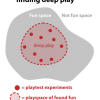Mapping the playspace
Here’s the process I used to map the playspace and create the various play modes.
- Identify: Identify the variables. Many of the important variables in the original Steambirds were hidden away in code. Andy surfaced these in an XML file so they could be readily tweaked.
- Explore: Methodically explore the space. I created a matrix of planes, each with one variable pushed to the extreme. Then I played them. The majority were unplayable and I’m not sure a single one made it into the final game. However, through the process of testing concrete variations, I gained a sense for what worked and what didn’t. I was mapping out the Goldilocks zone.
- Theorize: Now that I had some data, I created theories for fun planes. “I think that a slow, short range plane that needed to trap enemies in webs of poison trails would result in interesting tactics”
- * Test: Then I would change a few variables and try it out. Did the theory yield a new way of playing the game?
- Refine: At this point, we’d iterate on the plane many, many times to get the feel just right.
- Cull: We made a lot of planes. Some were more fun than others so those got chopped and the good ones stayed. This follows the philosophy of designing from a position of plenty, where you are overflowing with good content and can choose to put forth only the best.
(via Lost Garden: Steambirds: Survival: Goodbye Handcrafted Levels)
